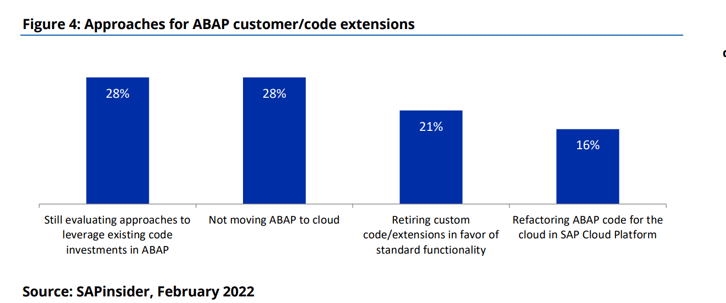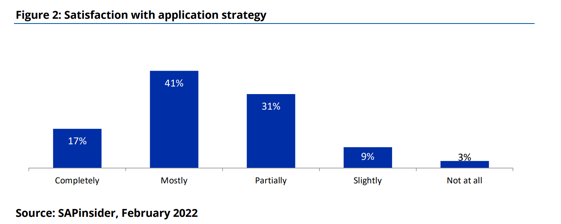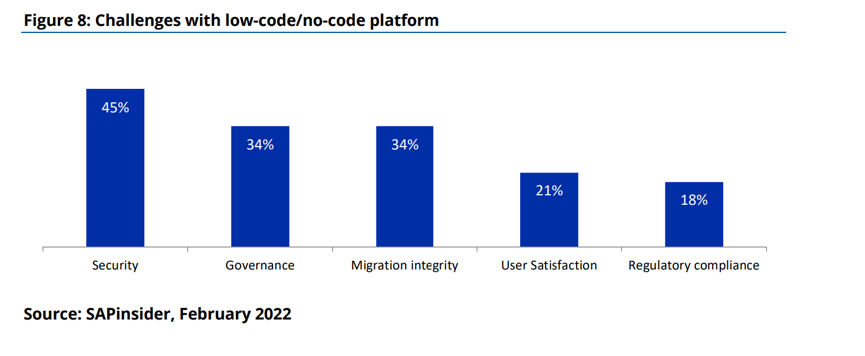Application development strategy
There’s always a degree of pain with changes to a business’s IT environment. So, it shouldn’t be a surprise that in an era of digital transformation, evolving technology, and new value-packed software solutions that businesses are experiencing some growing pains. SAPinsider’s Application Strategy and Development for SAP S/4HANA and Cloud Benchmark Report found that issues boil down to two somewhat opposing forces. SAP users are searching for ways to monetize existing investments in custom code while moving forward with plans to modernize their IT systems – and minimizing risk in the process. SAPInsider’s benchmark survey of 141 IT professionals around the world in early 2022 took a deep dive into SAP users’ application development strategies, goals and challenges and used the results to offer guidance for creating an effective application development strategy. The first finding paints a picture of the status quo: The majority of companies have an enterprise-wide application development strategy, but about half aren’t satisfied with its impact.
For many, the root cause of that dissatisfaction stems from legacy ABAP code. Many enterprises’ custom code is years (or even decades) old, and it stands in the way of maintaining a clean SAP core. Additionally, it’s common for the developers who wrote the code to have long moved on to other roles positions, and the custom applications that businesses use are often not well documented. Therefore, modernizing custom applications is a time-consuming and resource-intensive process – if resources with necessary skills are available at all. Job applicants with ABAP and cloud expertise are rare as the IT skills shortage continues.

On the cusp of a transition to a new IT environment, e.g., from SAP ECC to SAP S/4HANA, businesses have pivotal decisions to make. The survey found about half of SAP users are investing time and resources into rewriting ABAP code, some are retiring it and transitioning to standard functionality, and some are not moving ABAP to the cloud, necessitating a hybrid environment. Furthermore, 28% are still evaluating their options. The question, similar to the one you might grapple with when you are planning to move to a new home, is whether to take all the baggage with you and pay movers to do it or clean up before the move.

Consider Taking Your Enterprise’s SAP Application Development Strategy in a New Direction
Modern technologies offer enterprises additional options for developing applications that keep your SAP core clean and modernizing ABAP. SAPinsider research found the most common tools are SAP S/4HANA, SAP Fiori, and SAP UI5, as well as industry-specific applications. Additionally, the benchmark study found that much of the development is aimed at creating cloud applications, with the following:
- 38% on the SAP Business Technology Platform (BTP)
- 34% as progressive web applications
- 33% for SAP S/4HANA
- 28% for SAP UI5
- 28% on low-code/no-code platforms.
Interestingly, although 48% of companies are considering using low-code/no-code platforms, only 10% of survey respondents feel their team has "mature” low-code/no-code platform skills, and 74% say their teams have limited or no skills. Additionally, companies perceive challenges with low-code/no-code platforms. Security is a concern for 45% of organizations, in addition to governance (34%), migration integrity (34%), user satisfaction (21%), and regulatory compliance (18%).
The truth is, however, that a low-code/no-code platform such as Pillir is designed to prevent those challenges as businesses execute their application development strategies, whether the goal is adding net new applications to improve business processes or to modernize ABAP custom code. A side-by-side platform like Pillir frees an enterprise to develop the applications it needs to optimize business processes without modifying its’ SAP system, keeping the core clean. With this approach to an application development strategy, businesses save time and costs maintaining their IT environment, keeping it secure, and remaining agile as their industry and business goals change.
Additionally, Pillir also addresses concerns over the skills needed to use them, app integrity, and user experiences. Pillir’s low-code platform is designed to be easy to use; developers will find it intuitive and fast thanks to features like Scratch-style blocks on a drag-and-drop interface that enables speed and accuracy. Moreover, even people without development experience can participate in the application development process by using graphical interfaces rather than attempting to understand code or syntax.
Also, because Pillir’s EdgeReady platform is purpose-built for modernizing ABAP custom code and giving enterprises a path to digital transformation, the apps you create on the platform are seamlessly integrated with SAP. The platform also gives you the ability to control technical debt with an ABAP Analysis Dashboard that shows the total cost of ownership (TCO) of custom objects and identifies customizations you need to remediate. However, you stay in control. Pillir allows you to map and review code before publishing.
Pillir also understands that optimizing user experiences is key to productivity, efficiency, and job satisfaction, particularly as a part of your enterprise mobile application development strategy. With the platform’s graphical interfaces, you can customize screens and fields, so employees have exactly what they need. Furthermore, employees who work remotely will appreciate the platform’s industry-leading offline capabilities that enable the same SAP workflows, including entering data into SAP documents, work orders, or purchase orders, tracking time, and updating inventory, with or without a network connection. When connectivity is restored, Pillir’s platform syncs data accurately and securely, leveraging conflict resolution, error management, process continuity engines, and more.
Elements of an Effective Enterprise Application Development Strategy
Your application development strategy must start by aligning with business goals, whether it ultimately involves low-code/no-code development, refactoring custom code, or foregoing legacy apps for standardized functionality.
SAPinsider has created the DART model – Drivers, Actions, Requirements, and Technologies – which provides the framework for an enterprise’s application development strategy and a summary of its survey’s findings.
Although the framework is valuable for organizations devising or upgrading their application development strategies, remember that you need to create a plan that is unique to your business.
In a panel discussion with SAPinsider on the benchmark study, Vaidya Aiyer, founder and CEO of Pillir, commented, “It’s not easy. In the past, there weren’t many choices if you needed custom applications. Businesses knew about keeping a clean core but couldn’t implement it. Now it’s coming back to bite us.”
He pointed out that even with a tool like Pillir that can help enterprises modernize ABAP code and create new future-proof applications that work on any platform, companies need to define what they want to accomplish and establish clear goals rather than just jump on the low-code/no-code technology bandwagon.
Jelena Perfiljeva, an expert developer at Mindset Consulting, added, “The only mistake you can make is to do nothing. You can’t turn back time, but you need to make decisions. The longer you wait, the worse it will be.”
Final thoughts on application development strategy
Based on the benchmark study results, SAPinsider suggests that enterprises reflect these considerations in their application development strategies:
- Take an enterprise-wide strategy: With an enterprise-wide approach, businesses will increase their ability to extract the greatest value from existing custom code investments and from new SAP and third-party solutions. It enables faster time to market, cost control, and long-term goals such as a clean core.
- Prioritize integrations: Evaluate and use the best integration tools and establish governance to meet goals and minimize issues.
- Plan ABAP code modernization: Make sure you don’t move forward without a plan to address legacy code so that your operation maintains critical functionality and minimizes technical debt.
- Identify high-impact use cases for low-code/no-code development: Evaluate rapid application development platforms and leverage them to ease the burden on your IT team, speed the development of new applications, and increase collaboration between developers and line of business managers.
To read more please download the SAPInsider market research







 Back
Back/Logo%20-%20black%20text%20blue%20pillar%20(large)-1.jpg)

